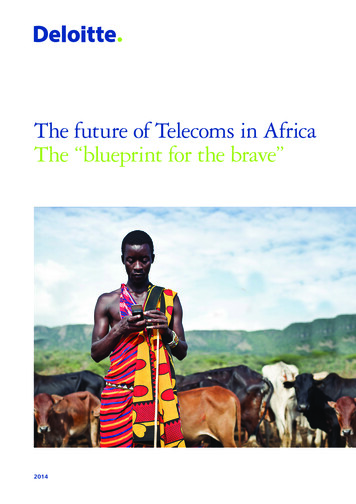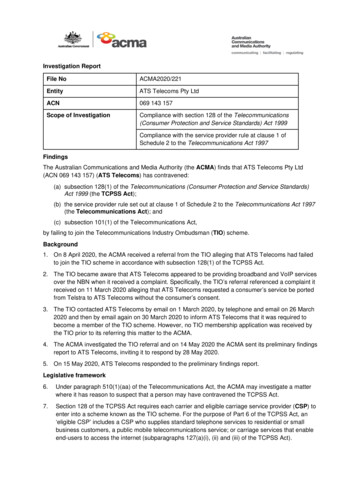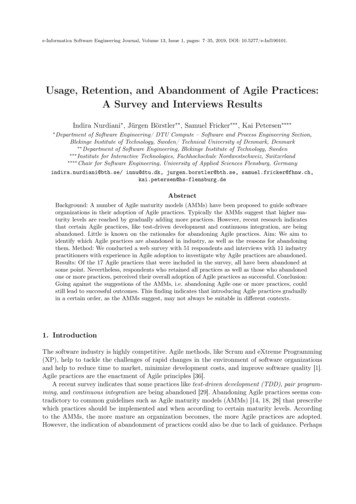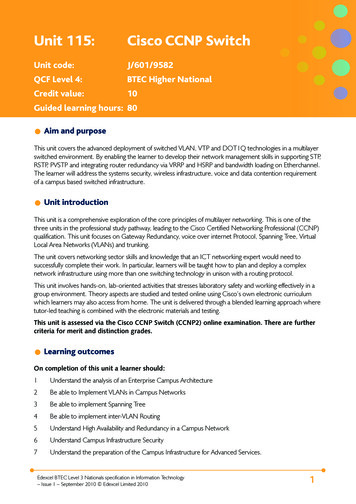
Transcription
The future of Telecoms in AfricaThe “blueprint for the brave”2014
ContentsForewordForeword1Fast rewind on some key trends2African growth and the rising of the African middle classSubscriber growth remains strong but is maturing – rural may be the next frontierMobile markets are slowly moving towards lower revenue growth levelsTelecoms services (voice mostly) continue to be commoditisedMost telcos have embarked on a journey of cost consolidation and diversification “The Blueprint”A transformation towards new operating models through operational innovationVoice: differentiating and keeping an edge on tariffs whilst maintaining profitabilityData: banking on the (still oncoming) data tsunami?Data demand:What are the use cases for the new African middle class?What are the use cases for African Businesses?Data supply:Unleashing international connectivity to fuel growthDomestic infrastructure sharing, acting as a catalystData access networks are ramping up, but slowly (a costly process)IT services: a rapidly changing competitive landscape in a rapidly growing marketMobile money: getting on to the next phase (maturity)Media: how to make middle classes enter a mobile digital age?Mobile advertising: set to grow345678910Key drivers for telecoms M&A and current opportunities20Key drivers for telecoms M&A: not necessarily about hype1. Integrating telecoms operations: cross border and in-country mergers2. Reassessing core and non-core3. Diversifying the telecoms services portfolio and beyondCurrent opportunities:General themesFixed and Mobile Telecommunications providersOther private sector opportunities (Media, ISPs, Mobile tech)Licences21222324Our credentials29Deloitte global M&A presenceDeloitte African footprintDeloitte TMT – our global “ what surprises me is theinterest from global advertisinggiants in telco acquisitions inthe race to secure access to thegrowing African middle class”Mark Casey, TMT Industry Leader – AfricaAfrica can no longer be considered the DarkContinent. Given the rate at which mobile connectivityis growing, it seems only natural that the way businessis done will change. But how will Telco’s embrace thischange and are they even ready for it?Deloitte has recently completed an in-depth analysisof the market, its trends, and the drivers of it. Weare convinced that there will be consolidation inthe telecommunications sector and inevitably moreinbound investment as the market opens up and theeconomic returns improve.While the future shape is still far from clear, we seefour potential scenarios:1. Winner takes all – as the markets consolidatequicker than most operators can respond;2. Turf wars continue as new and existing operatorsbattle it out for the profitable market and arejoined by banks trying to protect their core businessagainst mobile payments;3. New entrants come into the market fromadjacent sectors with greater added value thanthe traditional carriers – foreign media and evenadvertising groups are viewing telcos as a readymade channel to market; and4. Owning the hearts, minds, and wallets ofconsumers is the end goal. Will telcos, who havelaid the foundation for connectivity and access, bethe winners; or will it be global technology groups,the banks, media, advertisers or retailer giants?The impact in not just on the industry incumbents,but on all players in their respective value chains(hardware, software, services and people provisioning)as they reposition their offerings to keep in step withan unchartered end-state.Indigenous companies, foreign investors, and globalplayers have all made significant investment into thecontinent or certainly parts of it. Even governmentsare waking up to the opportunity to regulate and toauction spectrum and licences.“ industryboundaries aredismantling, andowning the consumerexperience space isthe prize”Arun Babu, TMT Southern AfricaThe future of Telecoms in Africa The “blueprint for the brave”1
African growth and therising of the Africanmiddle classThe worlds second fastest growing region andits growing middle classAfrican contribution to global forecast real GDP growth2011 GDP distribution (x-axis); GDP growth 2010-17 (y-axis)Africa: is forecast to growat 5.5% CAGR between2010 and 2017, beatenonly by emerging Asia, ofwhich China representsthe large majority of thegrowthChina: c.12%of global GDPEmergingAsia6.7%Fast rewind onsome key trendsAfrica is one of the fastest growing regions in the world, with a forecastreal GDP annual growth rate to 2017 of 5.5%. Over the next decadec.100m more people are expected to join the African middle classAfrica5.5%MiddleEastLatinAmerica4.5%5.1%A decade of rapid GDP growth .C&EEurope Africa has grown at 8.7% CAGR in real GDP terms between 2000 and 2010,making it the second fastest growing continent in the world, only behind chinapropelled emerging Asia. Third party forecasts suggest Africa will continue togrow very rapidly at c.5.5% CAGR to 2017 Part of this rapid GDP growth relates to improved international trade and anaccelerated pace of foreign direct investment, in particular from emerging superpowers such as China and Brazil. Many major multinational corporations invest inAfrica, both in natural resources, infrastructure, goods and services. Large brandssuch as Unilever, Diageo and Parmalat have entered Africa’s consumer market3.4%North America,Western Europe anddeveloped Asiancounties1.8%Concentration of the middle classA wide disparity between countries There surely remain impediments to growth – road, rail infrastructure and powercan be scarce, political instability and corruption are still widespread, regionalintegration is progressing only slowly but all these elements are improving andmaking long-lasting impacts. has created a growing African middle class Africa’s contribution to global GDP remains small at 2.7% but growth experiencedto 2010 has put total consumer spending in Africa ahead of Russia and equal toIndia, albeit fragmented across many countries Whilst there is a wide disparity among income levels across the continent, GDPgrowth is positively impacting individual earnings and private consumption,migrating an accelerating number of people into the African middle class – thosespending between 2- and 20 a day Between 2000 and 2010 the number of people in Africa’s middle class grew by130m, forecasts from the African Development Bank suggest that at least 100mmore people may become middle class by 2020“ those companies who aresuccessful members of theexisting telco value chain willneed to have a hard look at theirfuture strategies or becomeredundant over time”Jim Sloane, Global TMT – Africa2Middle classconcentration High Medium LowA growing African middle classProportion of population by group100Average dailyconsumption: 20 4- 20 2- 4 2908070605040198019902000201020202000 to 2010: 26% uplift in peoplespending 2-20 per daySource: African Development Bank, World bank data, IMF forecasts, Deloitte ‘Rise and Rise of theAfrican Middle ClassNote: Africa 5.5% growth forecast: North Africa forecast (5.6%) SSA (5.5%)By 2020 c.100m more people willbecome ‘middle class’ in AfricaThe future of Telecoms in Africa The “blueprint for the brave”3
Subscriber growth remains strong but ismaturing – rural may be the next frontierMaturing subscriber growth in the AfricanregionRegional subscriptionsMobile subscriptions, annual growth50Africa is still thefastest growing, but isprogressively maturing40302010201120060 Africa CIS Arab States Europe Asia & Pacific The Americas1000Subscriptions (million)Mobile penetration900Fuelled by improved economic conditions, the last five years have seenAfrica experience the fastest telecoms growth worldwide, which hastransformed fundamental aspects of social and business lifeThe combination of slowing subscriber growth rates and rapidly reducingARPU levels is making revenue growth challenging in an increasingnumber of African marketsMobile subscriber growth remains fastest in the world, positively impactingtelecoms markets as well as African economies at large African mobile telecoms have witnessed massive growth over the last decade;subscriptions CAGR reached 42% during 2006-08 and 21% 2009-11. This rapiduptake has been mainly driven by:- mobile services being a core life enabler to all user segments- favourable macroeconomic factors flowing to higher consumption- licensing opportunities and improved regulatory environment Telecommunications growth Africa has positively impacted incomes acrossthe continent: in Sub-Saharan Africa, mobile revenues reached 35bn in 2011representing GDP contribution of approximately 3% Recent Deloitte and GSMA research states that a 10% increase in mobilepenetration in developing economies is likely to increase productivity by 4.2%Large countries with high subscription growth or comparatively higher ARPUlevels continue to be seen as high growth markets Subscriber growth remains fastest in central African countries such as in Nigeriaor Sudan and is expected to continue being concentrated in regions wherepenetration is comparatively low Whilst subscriber growth is slower in more mature markets such as Egypt or SouthAfrica, these markets continue to concentrate the largest net revenue potentialdue to higher income levels, large and growing populations and sustainedeconomic growthMobile subscriber growth is maturing and could well saturate in the mediumterm in some markets if rural coverage does not increase On average, mobile subscription penetration has reached 72% across Africa(3Q12) but country penetration rates vary Multi-SIM ownership is widespread and actual penetration of individuals couldbe closer to 40% to 50% in some countries, potentially leaving room for furthergrowth. For instance this is the case in Nigeria where mobile penetration is above60% but human penetration just above 26% with multi-SIM ownership at c.2.4per user Further growth in subscriber levels is likely to be driven by; (1) Lower call pricesand overall cost of ownership of handsets to gain access to lower incomesegments; (2) better network coverage in rural areas and operating modelsadapted to serving such remote connectivity needs; (3) mobile data connectivity(as well as M2M), which has already proved very successful in a number ofcountriesAfrican subscriber growth and penetrationMobile subscriptions and population penetration (2000-15)800700600500400300Mobile markets are slowlymoving towards lowerrevenue growth levelsThe drivers of future subscriber growth Further subscriber growth is likely to continue being driven by- lower call prices and lower overall cost of ownership for handsets, allowingpenetration of lower income segments- better network coverage in rural areas and operating models adapted to servingsuch remote connectivity needs- mobile data connectivity (as well as M2M), which has already proved successfulin a number of African countries (e.g. SA)- multi-SIM ownership in countries where it is still increasingHigh potential marketsMobile subscriptions growth2010-122013-14Subscriptiongrowth 15% 15-20% 20-30% 30%Mobile market net revenue potential2010-12The challenge: revenue-dilutive incremental subscribers As mobile operators continue to add subscribers to their network they typicallyreach out to harder to reach areas or segments and often either poorersubscribers or multi-SIM owners- incremental subscribers often spend much less than more affluent early adoptersof mobile services- reaching to specific niche segments or to remote areas, where competition maybe less strong can be costly, diluting margins2013-14200Forecast201502000100Large African markets withcomparatively high ARPUor high subs growth arelikely to remain Africa’s keytelecoms growth driversNet mobilemarket revenuepotential ( m) 100 100-200 200Source: WCIS, ITU, GSMA and Deloitte analysisNote: Penetration rates are based on active SIMs4Source: Deloitte analysis, Telegeography, ITU data, IMFThe future of Telecoms in Africa The “blueprint for the brave”5
6%7%11%10%86%201183%83% Data SMS and Other VoiceVoice: still themajor top line andprofit contributorGhanaNigerSenegalSouth we26Gabon30Togo22Ethiopia30In 1H12 Nigeria alsoexperienced almost30% reductions onavg.price per minute1718Libya200201160Namibia2009-10KenyaVoice price reductions (2009/10 and 2011)% price reductions, lowest tariff1715139Regulation also puts pressure on average revenue per minute Special taxation on telecoms services has increased in some cases (e.g. Tanzania)or is being put in place (e.g. Egypt) Mandated declines in mobile termination rates have become steeperWhilst ARPU is pressurised, voice traffic levels continue to increase, pressuringthe networks and calling for capacity investments Aggressive discount policies and lower prices have led to significantly higher trafficlevels through volume-price elasticity Operators have been challenged to maintain minimum service levels and numberof them, such as in Ghana, Nigeria or Kenya have breached acceptable congestionlevels, sometimes leading to being temporarily barred from selling new SIMsPrice catch -upOperators are diversifying: seeking out growthlevers and incremental margins in data, IT,banking, and VAS Commoditisation of voice has pushed a dualpronged agenda for telcos, of both cost reductionand diversification Operators are seeking out higher returns inimmediate adjacent markets as well as highersegment focus, typically through strategic alliancesand/or acquisitions, e.g. in developed markets, launch of sub-brandsor MVNOs in case they can achieve furtherdifferentiation and better capture niche segments acquisition of fixed internet and data providersto complement mobile voice/data and retain thelucrative higher income segments, to differentiatewith businesses and achieve infrastructuresynergies deploying mobile banking services, as operatorssee themselves increasingly as service enablers forall aspects of usual day life, reaching agreementswith international remittance organisations aswell as in-country banking groups, with utilityproviders and with leading retail distributionnetworks extending services to convergent media offerings,and partnering with content owners such asDSTV or local media, with content providers (eg.Facebook), news and search (eg. Google), socialnetworking (e.g. MTN Pulse), gaming (MTN Play) advertising partnerships to potentially subsidizelow income segments and tap into internationalmarkets Differentiationpotential Data/ITMoneyV. high speedSavings,regulatedservicesData centre ionSMS, tionsPrepaid cards,non regulatedservicesIP coreData/ITRetailers PoSTransfersPaymentfacilitatorsSoftware MediaPremiumcontentApps factoryMobile appsMobileAdvertisingAdvertisingagencyOwn adplatformDifferentiationstrategyJoint adbookingplatformGoogle SMSsearchBulk, targetedSMS & VASPoSIntermediariesOnline mediaMobileAdvertisingDSTVMediaNiche markets20104%10%A conundrum of differentiation optionsAcquisitions mergers2009Voice still represents the majority of revenues by a large margin. A numberof countries are seeing an acceleration of voice ARPU decline throughcompetition Voice still represents the majority of revenues for operators. In the case of thisTelcos’ key markets, voice represented over 80% of revenue in 20111 ARPUs have been declining as a natural result of lower price levels, lower incomesegments being penetrated and customers spreading usage across multiple SIMsto maximise value from various mobile tariffs In some countries, competition has heightened price pressure, resulting in fasterdeclines, such as in Kenya in 2008-09, in Ghana in 2010, or more recently inNigeria (1H 2012). In such cases traffic does not compensate for lower revenueper minute, i.e. volume-price elasticity is lower than 1 The acquisition of Zain by Bharti (2010) triggered several such cases across Africaand resulted in a number of price wars during 2011Whilst operators are seeking to contain costs,they also seek revenue growth through servicediversification: banking on data, businessICT services, mobile applications and mobileadvertisingStrategicpartnershipsTypical Telcos’ revenue composition1PercentageVoice is still the major revenue earner for most telecommunicationsoperators. Tough competition has meant rapid declines in revenue perminute in key markets and accelerated decline of voice ARPUsServiceextensionsVoice ARPU dilution through aggressive pricingand low income segmentsMost telcos have embarked on a journey ofcost consolidation and diversification“The Blueprint”Mass marketTelecoms services (voice mostly) continue tobe commoditisedMoneyInfrastructure VOICECostconsolidationstrategySynergy potential/cost benefitIn achieving differentiation, there is a fine line toconsider between what is eligible for partnershipsand what is more relevant for M&ASource: Deloitte analysisIdentifying the appropriate execution path ischallenging In most cases, there is only a small divide betweenwhat is eligible for partnerships and what is morerelevant for M&A, often a result of the availability ofopportunitiesSource: MTN Annual reports, GSMA / Wireless Intelligence, CTO 2012, Deloitte analysisNote: 1. Voice (Airtime and interconnect), SMS & Other (SMS, handset revenues, accessories and other), Data (all non-SMS data), The Telcos’ markets includes South Africa,Nigeria and Ghana6The future of Telecoms in Africa The “blueprint for the brave”7
Network site securityManaged services & VASCustomer Service centreTechnical field maintenanceNetwork ITBillingPrepaid distributionCash collectionBrandingInfrastructure carve outs: Tower transactionsA plethora of 33752Jan 10TanzaniaTigoHelios801020Sep 10GhanaVodafoneEatonna750Oct 10South AfricaCell-CAmerican4303200Nov 10NigeriaStarcommsSwap tech81407Dec 10DRCTigoHelios45729Dec 10GhanaMTNAmerican2181876Dec 10UgandaMTNAmerican1751000Dec 11UgandaWarid/OrangeEaton153694Mar 12RwandaRwandatelAirtel16naApr 12UgandaWaridEaton60400Oct 12CameroonMTNIHS143827Oct 12Ivory CoastMTNIHS141931Oct 12EgyptnaMobiservenanaOct 12Cameroon & Ivory CoastOrangeIHSna2000Apr 13KenyaTelkomEatonna1000Jun 13TanzaniaVodacomHelios751149Jul 13RwandaMTNIHSna524Dec 13ZambiaMTNIHSna704Dec 13Source: specialised press, project experience, company news releasesNote: 1. Shared Service Centres8TowersDateIncreased focus on cost control, re-assessmentof core areas of service value add and costdifferentiation vs. non core In the last two years African telcos turned their focustowards cost control and operational efficiency, aresult of market maturity possibly accelerated byacquisition of Zain by Bharti in 2010 Downsizing operations is difficult as it requires anacute sense of what can be a differentiation elementtoday or in the future, and what can be bestachieved outside the organisation Typical areas where operators have focused theirefforts have been in setting up ABC controls,outsourcing managed networks, site maintenanceand security, and back office functions in SSCs1Sharing has been commonplace for African telcosbut with tight margins and investments calls,releasing value through tower deals has becomemore attractive and has gathered pace There may be c.170 000 towers in Africa, and agood share of them are already shared betweenmarket players, whether through regulatory pressure(increasingly so) or not Releasing value through towers is attractive andmany operators have gone down this route, albeitunder different types of models (JV, asset sale,operate and maintenance, co-location rights) Four main outsource partners have emerged,Eaton, Helios, IHS and American Towers and areconsolidating tower portfoliosFinding appropriate operating models to break therural frontier Reaching rural areas is a necessity for manyoperators willing to expand. This is no small feat ascosts rapidly spiral up – for instance energy or sitemaintenance – whilst income levels reduce Super low cost models are being tested anddeveloped, e.g. Movitel in Mozambique, VNLin Ghana (DIY low power solar solutions), solarchargers (Vodacom) or through projects such as‘openBTS’, ‘the village telco’Tariff innovation is still a core differentiationelement for African telcos as they compete tocapture niches and the low end market African ARPU levels have not just reduced becauseof reaching low usage segments but also because ofgenuinely stiff price competition Differentiating on price is a core element of Africanoperators tactics as markets mature and as theyreach to niches and the low end market Because voice remains the #1 profit contributor andbecause elasticity is critically high, such tactics haveto be managed very carefullyHow to be both innovative and profitable? Tariff innovation aims at achieving core benefitssuch as usage stimulation, securing fixed spend,leveraging yield on under-used assets, servicebundling or securing segment niches andcommunities. Whilst pricing tools vary with objectives, most tariffscompete on the best set of ‘freebies’ to offer (e.g.free usage, cinema ticket, wifi ticket) Experience shows that new tariffs often have adisruptive adverse impact on markets, whether onoperators’ top line or on competitors’ reaction tonew pricing structures. Typical pitfalls include:– making tariffs available and attractive to too manyusers at once– not anticipating the reaction of competition as awar game– overlooking the road-testing of tariffs during pilots– overlooking side-effects, which analytics can helpunderstand, such as socially linked consumergroups, implied churn etc.Do MVNOs and sub-brands have a right to play? African MVNOs make c.0.5% of MVNOs globally.For many, Africa would have too low ARPUs andlack price stability, lack licensing or the ability todifferentiate over distribution or operating model They are a growing area of focus though, inparticular in the most developed markets such asSouth Africa, Egypt or Morocco. Regional platformscould well develop across markets with regionalMVNEs-8%Algeria9Cameroon8Sudan8‘Lean’ a4Uganda4121310MNO ASPUFinance Service centreMVNO economics (illustrative)A lean model to lead on cost? ( /user)MVNO ASPUManaged radio networkARPU evolution 2007-11Average market ARPU ( /month) (CAGR)InfrastructureTower site managementA never-ending downward trend on prices through tariff ‘innovation’‘Lean; opexOperations outsourcingExamples of recent outsourcing activities amongst African telcosTariff innovation is tactical, always in focus andgeared towards maintaining share, stimulatingdemand and migrating towards data – it isalso disruptive and has weighed dearly onprofitability in recent periods.Wholesalecall costsWith higher traffic levels, extended networkreach and targeted investments in new services,the need for operational efficiency has becomeeven greater. Sharing and outsourcing havetaken centre stageOperations and towers outsourcingVoice: differentiating and keeping an edge ontariffs whilst maintaining profitability per userA transformation towards new operatingmodels through operational innovationSelected examples of tariff innovation, AfricaBalancing tariff innovation and profitabilityTariff conceptBenefitsFlat tariffs - weekly/daily booster, unlimitedtariffs pass a daily/hourly spend smaller package top-ups stimulates usage higher flexibility, loyaltyYield benefits - Dynamic discounting based oncell usage Yield, geographic price deaveraging/ ruraldiscountsUsage stimulation: get benefits pass a level, freecall/hour/day hybrid approaches rather than contractualcommit. ‘talk for X long, get Y free’Service bundling: extend beyond ‘telco’ lifestyles, digital media total connectivity (fix/mob)Secure niches - targeted discounts achieve attractive tariffs for targeted segmentonlyDifferentiating MVNO elementsWestern Europe vs. AfricaCore conditionsWEAfrAfrican contextExisting MVNO regulation few markets eg. SA, EG,MAWilling MNO host network few markets eg. SA, EG,MAHigh ARPU & price stability few markets eg. SA, EG,MADifferentiating distribution loose distribution structureLeaner operating model African opcos fairly leanSegment-specific value-add e.g. Set’ Mobile CameroonSegment-specific tariffs e.g. Econet Wireless SARetail brands to leverage e.g. Virgin SA, Red Bull SAExisting MVNE infrastructure no regional MVNOsApart from more mature countries such asMorocco, Egypt or South Africa, Africa is amuch harder environment for launching MVNOsSource: GSMA, operators websites, project experienceThe future of Telecoms in Africa The “blueprint for the brave”9
Growth of dataBandwidth usage, AfricaInternational usage, Gbit/s2007-11 CAGRData: banking on the (stilloncoming) data tsunami?Data demand: what are the use cases for thenew African middle class?Africa’s total bandwidth usage grew at 85% CAGR between 2007 and2011, a rate of growth beaten globally only by the Middle East. Mobiledata now makes a noticeable contribution to operators’ revenuesConsumer data demand is driven by the need tocommunicate, by innovative online services andrich-form entertainment. There is a wide gaptoday between consumers’ ultimate aspirationsand existing supply85%20072009200920102011Data share of revenueKey players, Africa only20 MTN Vodacom Safaricom1510502009201020112012Regional bandwidth usageCompound annual growth 2007-11Middle47%da98%47%Secope Oceana US &CanaSustained significant growth is also expected for the period 2013-17 Cisco considers that Africa will be the fastest growing region in terms of mobiledata traffic and will grow by c.77% CAGR (17 fold) over the 2013 to 2017,generating by 2017 over 0.9 exabytes/month of dataEastatEurosttheAminAsiaricaData share of revenueRegional averageL71%est growAf r i ca85%nd fa55%58%Developing data infrastructure has been a challenge but significant growth inusage is now visible Developing international and national infrastructure for Africa has been a longprocess involving many stakeholders in funding the development of internationalhubs and domestic infrastructure Bandwidth usage grew at 85% CAGR in 2007-11 mainly driven by: declining prices, essentially a result of submarine connectivity latent demand met by increased data supply increased speeds and quality of service Telecommunications operators are progressively evolving their business modelsand network infrastructure towards data connectivityDatainc is likrealevelyselsclo ing o to contveseroth to t r tim inueeherMEAma ose s , torkeets en inLatin19%AData revenues are now an important contributor to operator revenues – theprofitability of data now needs to be carefully though through For major players, data has already become an important contributor to totalrevenues. In 2012, non SMS data contributed 14% of total revenues for Vodacomand 7% for Safaricom As data increasingly contributes to operator margins, its standalone profitabilityneeds to be carefully thought through, from infrastructure investment cases tosubscriber acquisitions, beyond demand stimulation building a data market is a balancing act between funding demand stimulationthrough lower margins (e.g. low data prices; attractive local content online:MTN and Afrinolly content application) and making data profitable in the longerrun this will require crafting an appropriate mix of access technologies (3/4G, Wifi,WiMAX) and data services to grow operations in a profitable wayEcaeri26%rope Asia & PacificJapan. Eu28%47%32%Consumer needExample products and ing andsocial datacommunications Communications with friends, family andcolleagues In multiple format across many different types ofplatforms Using in the first instance lower grade products(e.g. 0.facebook) but rapidly moving to improvedinterfaces Accessing local interfaces that fit African commscultures Google SMS service: allows access to Gmail via SMS; Google search gateways isanother popular service allowing searches through SMS MTN and Orange have each developed data light versions of Facebook (e.g.0.facebook) to be accessed over low-grade mobile phones Since May 2012, Facebook is the most visited internet site in Nigeria 1 Mxit developed very rapidly as the #1 social networking in South Africa, battlingwith FacebookFeatures of newlife and businesssupport services &information Life-enabling services e.g. job, transport updates,translators Banking services, for the un-banked orunder-banked eGovernment services such as health services,for those unable to reach advice Small business support services such asAgricultural services, to access crop price orweather information Daktari 1525 is a partnership between Safaricom and Call-a-doctor, it offers adviceand referrals (however it does not offer online diagnosis) Mfarm is an SMS based service which allows farmers to check the real time cropprices Citizen TV (Kenya) is one of many African news channels available also emitting onYou Tube for online information access Voice of America keeps Nigerians up to date with an SMS based news serviceA strong desirefor mediaentertainment inrich format Digital entertainment in its widest possibleform, delivered to individual homes or directlyindividuals rather than through collective access Wider offerings, currently not met/distributed bylocal television or other media Catch-up trend of African population towardsnon linear online entertainment services YouTube partners in South Africa, Nigeria, Kenya and Uganda with contentproviders such as Nollywood Love and Lagos TV for local offerings New form factors are emerging, from smartphones apps (e.g. MTN Afrinolly) tosimple low-cost connected web TVs such as Vodacom’s ‘Webbox’ Traditional forms of enter
Source: African Development Bank, World bank data, IMF forecasts, Deloitte 'Rise and Rise of the African Middle Class Note: Africa 5.5% growth forecast: North Africa forecast (5.6%) SSA (5.5%) Emerging Asia 6.7% Africa 5.5% Latin America 5.1% Middle East 4.5% North America, Western Europe and developed Asian counties 1.8% C & E Europe 3.4% .










